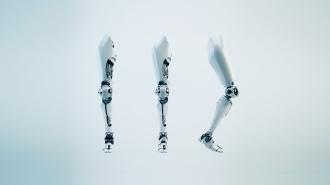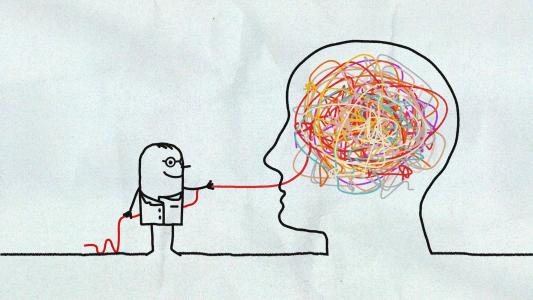If you could have one superpower, what would it be?
Hugh Herr thinks, one day, you’ll have options. As a bionic designer at MIT, Herr is working to bridge the gap between the brain and a new generation of synthetic limbs, which may even outperform normal human arms and legs.
His latest project aims to give amputees the ability to sense where a prosthetic limb is and how it is moving — the way you just instinctively know where your arm is relative to your body. Sensors are connected to muscles where the prosthetic is attached, allowing the brain and the robotic limb to “talk” to each other, restoring a sense of body position and movement.
After losing his own legs in a mountaineering accident, Herr was fitted with prosthetics. Not willing to accept that he would never climb again, Herr was back on his synthetic feet scaling walls less than a year later. Unsatisfied with his options, he designed and redesigned his own bionic feet until his climbing ability was so much better that some climbers even accused him of “cheating”. He didn’t stop there — now, hailed as a bionic pioneer, Herr heads the Biomechatronics research group at MIT.
Freethink spoke to the trailblazer about his vision for the relationship between technology and the human body.
This interview has been edited and condensed for clarity.
Freethink: Could you explain the landscape of bionic technology and what makes your perspective unique?
Hugh Herr: Most designers develop synthetic designs that attach to the body or (are) implanted inside the body. So they view the biological body as invariant, and they ask the question, “How can we design materials to create bionics to augment the human?”
We relax that constraint, and we ask, “How can we co-develop, co-design, both the biological human and synthetic design to augment performance?” So this notion that the human is unchangeable and invariant and not something that can be designed and improved upon is something that we relax. I call this neural embodied design.
Freethink: Some people might be uncomfortable with the idea that it would increase ordinary human capability. Why do you think that is? Should we be allowed to use these advancements to enhance human performance?
Hugh Herr: Technology is human thought expressed in the physical world, where the objective is to expand human choice and expression. So if a person chooses that they want to run faster, jump higher, think faster, have more empathy, or whatever the augmentation is, that’s the domain of bionics — to provide them that capability, that freedom, that expression.
We’re surrounded today in “normal life” with augmentation technology. We have automobiles that go much faster than our legs. Airplanes. Smartphones. We’re incredibly augmented. So this idea that it’s scary to be augmented, just look around — you’re using it.
“Will a person with biological limbs volunteer or choose to have bionic limbs? One day, probably.”
Hugh Herr
I think some people get uncomfortable with the more intimate changes to our bodies. It’s fine to strap on a bicycle and go much faster. But if you have a bionic limb that’s physically attached and neurally attached to the brain, that somehow becomes more threatening. Everybody has their line in the sand of what they’re comfortable with and what they’re not comfortable with.
Freethink: And where is your line?
Hugh Herr: To me, it’s a question of human health and a question of human freedoms and respecting human diversity. So any technology that makes us more dormant, less expressive, less thoughtful, less empathetic, I think is problematic. We have a lot of such things. We have television, which may fall into that domain.
Technologies that enhance, that expand choice, that may even be fun, I gloriously welcome into the world. I think it’s a natural extension of humanity, of our evolution.
Freethink: You’ve been outspoken in support of athletes who compete with bionic limbs. How do you think this will change the future of sports?
Hugh Herr: A sporting event such as the Olympics — you can view it as a celebration of what an innate physiological body is able to do at the extremes of genetics, at the extremes of training, and diet, and so on. There are other sports — such as race car driving, and some areas of Paralympics, sailing, cycling, and so on — that are a celebration of human-machine interaction. As technology creeps up in those human-machine sports, the performances improve.
If you have a person with an artificial limb running the 100-meter race, that’s a human-machine sport. There’s this huge effort to not expose athletes to technology in the Olympics. But for a person with an unusual body — like a missing limb or arm, or paralysis, or whatever it may be — it would be wonderful if we lived in a society where they were able to participate in sporting events such as the Olympics. So how might that be possible?
We need to have technology that does not augment nor is a disability — that captures the innate physicality, athleticism of the individual — which is very, very hard (to create) but will be possible in the future of technology. Technology is becoming more and more personalized. We need to leave the world of small, medium and large, the world of the average human, and enter in a world where your bra, your shoes, your hat, the implants inside your body — they’re all yours, and no one else can use them because they reflect your individuality. That’s where we’re going in design.
Freethink: Are bionic limbs the future of fashion and smart design? Is this important?
Hugh Herr: I wouldn’t say the future of fashion, but they will and they are becoming objects of beauty and means of aesthetically expressing oneself.
Many prostheses go through this arc. They first are a strange medical device. Then when they become commonplace, people start exploring them as body additions, as sculpture, as objects of beauty. Like eyeglasses, for example. There are many people that wear eyeglasses that don’t even have impaired vision. They believe the eyeglasses make them look smarter and look more interesting.
For prostheses, you’re beginning to see many examples where people are celebrating this human-machine intimacy, and building limbs that do not reflect human-like beauty but other forms of beauty — like machine beauty, objects and sculpture, beautiful lines, beautiful abstractions. That’s wonderful.
“Technologies that enhance, that expand choice, that may even be fun, I gloriously welcome into the world. I think it’s a natural extension of humanity, of our evolution.”
Hugh Herr
Right now, we live in a society where there’s a mitigation of human diversity because of humans’ very narrow perspective on what beauty is and what intelligence is. When you say “beautiful woman” or “beautiful man,” we have these very narrow definitions. When we say “intelligence,” we have these very narrow definitions of intelligence.
The dream is, with bionics, we blow that apart, and many, many types of bodies are beautiful. Many different forms of cognition and expression are beautiful.
Freethink: Do you think this would someday — or should someday — be accessible to most people, even to someone like me, just your average journalist?
Hugh Herr: Generally, exoskeletons and various forms of implants, absolutely. Will a person with biological limbs volunteer or choose to have bionic limbs? One day, probably. Certainly if a biological limb doesn’t work very well. So, for example, if you’re 70 years old and your hands are arthritic, and you want to knit, or you want to throw a baseball, and we live in a world where you can build a bionic limb that’s as good as your 18-year-old arm and hand — it’s completely rational to upgrade.
What’s critical is human choice, human freedom. The society has to give that choice to the individual. We can never be forced to do something, forced to upgrade. Which is a challenge. The common story is, if we have all this augmentation technology, and the augmentations are indeed profound, it will be difficult for people that do not choose to augment to compete in the workplace and sports and so on. Then there’ll be this tremendous pressure for people to use such technology. That’s not a new idea, we see it in today’s society. Clearly, with a smartphone, one is able to be more effective in life than with a flip-phone that costs $8.
A large percentage of high-powered undergraduate institutions, the student body is on some pharmacological augmentation when they study — approaching half of the student body. So can the other half actually get the same types of grades? Do they feel pressured to take the same pills? These are issues that we’re already struggling to grapple with.
Freethink: This technology can be very expensive. Do you envision a future where this technology is accessible to everyone who needs it, and how would you foresee us getting there?
Hugh Herr: Technologies always go through an arc. Mobile phones used to be very large and very expensive, and only very strange people had them. Now we all have them, and they’re quite affordable. As a society we are able to design and manufacture very, very complex technology and put it into the hands of millions of people. You can’t get there unless you start with that large device that’s expensive, that only the few can afford and have. You can’t go from nothing to everyone having it in a day.
Freethink: “Agonist-antagonist myoneural interface” (AMI) — could you describe that? And how is that going?
Hugh Herr: Very, very well. This is one example where you can design the body to better communicate to machines and for machines to better communicate to the body. We want to build bionic limbs that people can feel, that are embedded in the nervous system, that are embedded in sensation.
So when you move your elbow, you can close your eyes, and you can feel the elbow’s position and speed. If I hand you a barbell, you can feel the increase in force or load on your elbow. That’s called “proprioception,” and that’s from biological sensors in each muscle and tendon that tell the brain the length, speed, and force on each muscle tendon.
So when we want to build a bionic limb, say, a bionic ankle, we surgically and regeneratively create a muscle pair for the synthetic ankle. When those muscles move in the body, the person actually feels it as a joint movement. So when they look down and see the bionic limb moving, they actually feel it as part of their nervous system, because there’s actual biological muscles.





